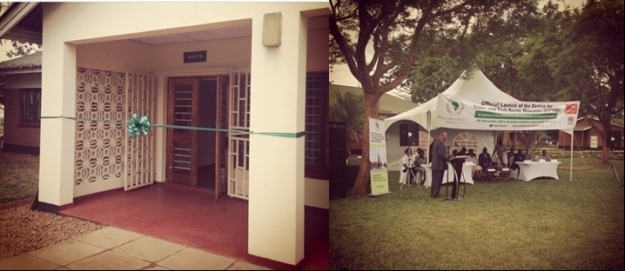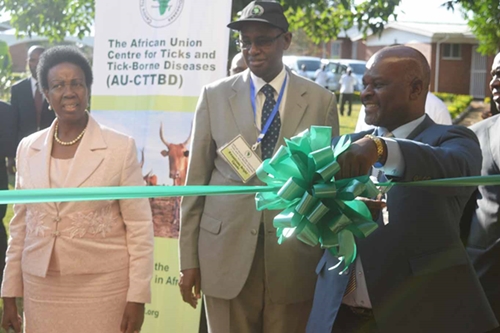Malawi Broadcasting Corporation report on the Centre for Ticks and Tick-Borne Diseases launch by GALVmed on Mixcloud
Author Archives: cttbdlaunch
CTTBD: Supporting African led solutions towards sustainable livelihoods in the livestock sector
By: Keith Bohannon, Member Development Officer at Scotland Malawi Partnership

Photo captions (l-r): The CTTBD ready for its launch on Friday 5th December 2014; Dr Hameed Nuru of GALVmed opening the CTTBD launch.
Having grown up in rural Ireland, I am very aware of the importance of agriculture to local communities, particularly in terms of providing livelihoods and stimulating economic activity. In many developing countries this reliance on agriculture is much more pronounced. For example in Malawi, as is the case for most countries in sub-Saharan Africa, almost 80% of the population live in rural areas and survive with very limited resources as subsistence small-holder farmers.
In such an environment where many households keep livestock such as cattle, goats and chickens, maintaining healthy animals can have a huge impact on the sustainability of the people’s livelihoods. This in turn has a huge impact on the opportunities available to members of the household in term of both health and education, particularly women and children.
At the Centre for Ticks and Tick Borne Diseases (CTTBD) launch today I learned that East Coast Fever (ECF) is the single biggest killer of cattle in Africa, killing more than 1 million cattle in the continent every year at an estimate cost of $260m in the east central region alone. Luckily there is a vaccine, in the form of the Muguga Cocktail vaccine. The challenge however is getting this vaccine to the people who need to access it most, where significant barriers exist in terms of access, cost and administrating the vaccine.
CTTBD: Reinforcing the business model
By: Beatrice Ouma, Communications Manager at GALVmed

Photo caption: Hon Dr Allan Chiyembekeza, Minister of Agriculture, Irrigation and Water Development, Malawi cuts the ribbon to mark the official launch of Centre for Ticks and Tick-Borne Disease, Malawi. Hon. Dr Bright Rwamirama, State Minister for Animal Industry, Uganda and H.E Tumusiime Rhoda Peace, Commissioner for Rural Economy and Agriculture, African Union look on.
The Centre for Ticks and Tick-Borne Diseases was officially launched on Friday 5, December 2014. The centre is currently producing the Muguga cocktail East Coast fever vaccine, which will be distributed to up to 11 countries in Africa.
Everybody I have talked to seems to read from the same script. It’s been a long journey for CTTBD to get where it is today, to be able to launch itself as a centre of excellence for vaccine production and training for young scientists in Africa. There have been a lot of challenges along the way. But also, everyone I have spoken to is optimistic about the future of CTTBD. Why? Because there is so much business potential for CTTBD and many hopes riding on the ECF vaccine. And with a deadly disease ravaging parts of East and Central Africa, threatening millions of livelihoods, the vaccine uptake may not be as big of an issue, but rather meeting the demand.
A vaccine that is transforming lives
By: Stuart Brown, Assistant Director of Business Development at GALVmed
Joy is a tough thing to bottle. To me, this photo, taken by my friend and colleague Dr Victor Mbao goes some way to encapsulating it. It shows the first moments in which liquid nitrogen was produced at a small laboratory in Lilongwe, Malawi – CTTBD, a lab which is having its official launch today.
“It was like a miracle to see the first spurts and coughs of liquid nitrogen at the end of a pipe going into one of our containers.”, Victor recalls. “The joy in members of staff was palpable. I knew this was the beginning of the journey to reducing the cost of production and delivery of CTTBD’s core product – ECF vaccine. Before then, nitrogen used to be shipped in from Zambia at great cost and inconvenience.”
The nitrogen is needed to store the vaccine and as CTTBD’s Acting Director, Dr Nkhwachi Gondwe-Mphepo shares, its arrival meant “…immense relief! No more sleepless nights as to when and where to get liquid nitrogen.” Nkhwachi smiles: “I felt like jumping up and down for joy! Like the rest of the CTTBD staff, I could not believe the problem of liquid nitrogen was now in the archives.”
Greater opportunity to control East Coast fever and other tick-borne diseases in Africa
By: Samuel Adediran, Assistant Director of Market Development and Access at GALVmed

Photo captions (l-r): The Muguga Cocktail ECF vaccination; GALVmed exhibition stand at the Kenya Livestock Producers Association in Kisii
The Centre for Ticks and Tick Borne Disease (CTTBD) in Malawi is now successfully producing the first batch of East Coast fever (ECF) vaccine, also known as the Muguga Cocktail. Because of this, there is now greater opportunity that exists for more effective control of this ravaging livestock disease in the “warm heart of Africa” and other countries in which ECF is endemic. The vaccine as such is not new, but its successful production at an African Union (AU) institution in Malawi is a milestone to be acknowledged and celebrated. Apart from the technical complexity of production, there were many other institutional barriers that GALVmed and other partners have been addressing to make this production a reality. Thus, the launching of the vaccine is a milestone – a bridge crossed. But now there are other bridges to be crossed in order to make this vaccine accessible to poor livestock producers. One of these is marketing and distribution of the vaccine to those who need it.
When writing about the challenges of access to animal health products for poor livestock producers in Malawi based on a scoping study, I observed that 90% of livestock in Malawi is in the small-holder systems based in remote villages and locations with poor access to infrastructures and without access to cold chain facilities. In addition, these farmers are poorly organised and lack access to organised markets and sufficient awareness of information and training in animal health practices that could transform their practices into income-generating ventures. Most of them have solely continued keeping livestock as a means of food for their households rather than to also generate money.
The CTTBD ECF vaccine: Responding to poor livestock keepers’ needs
By: Dr Victor Mbao, Programme Manager, Large Ruminants, GALVmed

Photo captions (l-r): Liquid nitrogen plant at CTTBD; ECF vaccine straws; ECF vaccine straws are stored in liquid nitrogen
The Centre for Ticks and Tick-Borne Diseases (CTTBD) is currently producing the ‘one shot for life’ Muguga trivalent (cocktail) East Coast Fever vaccine. With substantial technical and business support from GALVmed, CTTBD now houses state of the art production and research equipment and re-trained personnel. But CTTBD is not merely producing the vaccine originally developed by International Livestock Research Institute (ILRI) and other institutions such as KARI. CTTBD is actively researching how to improve the vaccine so that it responds to the needs of millions of small-scale livestock keepers and provide more practical ways of accessing the much sought after tick-derived ECF vaccine.
When you visit livestock keepers throughout Africa, one of their biggest cries is for a cheaper vaccine. But the most important factor to acknowledge is that these small-scale livestock keepers find it very difficult, almost close to impossible to meet the prerequisite of gathering together the minimum number of cattle required for a vaccination to take place before a 40 dose pack can be reconstituted. This is because most small-scale livestock famers do not own more than a few cattle per household and in most cases, the households are far apart making. In short, these farmers are calling for a cheaper, smaller dose pack of this life saving vaccine.
CTTBD: The Complete Full Circle
By: Dr Hameed Nuru, Senior Director of Policy and External Affairs at GALVmed
(25th November 2014) – Since 2008, GALVmed has taken on the daunting challenge of trying to facilitate the control of East Coast Fever (ECF) in Eastern Africa. I joined GALVmed in 2009 with a burning desire to see that challenge through to fruition and to show that things can be done, and done well, in the African livestock sector.
In 2009, and for three decades before that, ECF was not only an economic disease, but also a very political disease with actors all working independently and against each other. This resulted in a relatively simple disease not being controlled effectively and livestock keepers – poor and affluent alike – facing the wrath of an easily controllable disease. ECF actually has three methods of control (unlike most livestock diseases):
- Prevent the tick with dip solutions (Acaricides)
- Treat affected animals once sick with drugs
- Vaccinate using the Muguga cocktail ECF ITM vaccine.
GALVmed opted to go for the vaccination approach because, as we all know, vaccination is far more effective and prevention is better than cure.
Time for African livestock keepers to take control of their own destiny
By: Abdallah Said Twahir, Director of Market Development and Access at GALVmed

Photos (left to right): Cattle isolation unit; CTTBD grounds; CTTBD Tick House. Photos credit: A S Twahir
21st November 2014 – The Centre for Ticks and Tick-Borne Diseases, or just CTTBD as it is better known, is in the outskirts of Lilongwe, the capital city of Malawi. It produces a unique vaccine against a killer livestock disease responsible for large numbers of deaths in cattle. East Cost Fever (ECF or Ndigana as it is known in parts of Kenya and Tanzania) is responsible for over 1 million cattle deaths a year with considerable consequences on livestock keepers’ livelihoods.
However, a solution is available. A vaccine referred to as the ECF-ITM involves infecting an animal with disease-causing organisms and then treating the animal with a long-acting antibiotic to produce lifelong immunity.
It takes over 18 months to produce the vaccine at a considerable cost. The vaccine is expensive BUT not as expensive as the cost and effects of loss of livelihoods to the livestock keeper.
OFFICIAL LAUNCH OF THE CENTRE FOR TICKS AND TICK-BORNE DISEASES
(7th November 2014) – The Centre for Ticks and Tick-borne Diseases (CTTBD) in collaboration with Global Alliance for Livestock Veterinary Medicines (GALVmed) be launched on Friday 5th December as a centre of excellence in the East Coast Fever (ECF) vaccine production within Africa.
The newly refurbished, state-of-the-art centre produces the ‘one shot for life’ Muguga trivalent (cocktail) East Coast Fever vaccine with institutional support from GALVmed.
The centre, formerly known as the Vaccine Production Centre, was established in 1979 by the African Union and rebranded CTTBD in 2000. It was set up as a self-financing trust to assist with the management of ticks and tick-borne diseases in the region. The main objective of CTTBD is to provide support for the development of the livestock industry in Africa through:
- Training in epidemiology and tick-borne diseases
- Control techniques
- Production of quality-assured vaccines for tick-borne diseases
- Backup services to tick-borne disease vaccine application in the field
- Assistance in the investigation and control of tick-borne diseases
CTTBD is now producing the ECF vaccine, originally developed and produced by the renowned, Nairobi-based International Livestock Research Institute. Tick-borne diseases are one of the major constraining factors in the development of the African livestock industry. ECF is the most deadly of the tick-borne diseases as it kills millions of cattle annually. It affects 11 countries in Africa including: Burundi, Democratic Republic of Congo, Kenya, Malawi, Mozambique, Rwanda, Sudan, Tanzania, Uganda, Zambia and Zimbabwe. The disease devastates the livelihoods of dairy producers, pastoral livestock herders and small-scale crop and livestock farmers.


